Duck, Duck, GooseRecipes and Techniques for Cooking Ducks and Geese, both Wild and Domesticated
A lush, illustrated cookbook devoted to preparing and cooking ducks and geese, both domestic and wild, from the author of the award-winning blog Hunter Angler Gardener Cook.
Duck is having a renaissance in American restaurants and kitchens as cooks discover that diverse breeds, species, and cuts of meat offer an exciting range of flavors and textures. Many cooks—and even hunters—have a fear of cooking fowl. Duck, Duck, Goose shows you how to cook duck and goose like a pro: perfectly crisp skin crackling with each bite, succulent confit, impeccable prosciutto, and more.
Hank Shaw, an award-winning food writer, hunter, and cook on the forefront of the marsh-to-table revolution, provides all you need to know about obtaining, cleaning, and cooking these flavorful birds. Duck, Duck, Goose includes detailed guides on species and breeds, selecting a duck in the market, and plucking and hanging a wild bird. Shaw’s delicious and doable recipes include basics such as Grilled Duck Breast and Slow-Roasted Duck; international favorites like Duck Pho, Sichuan Fragrant Duck, Mexican Duck with Green Mole, and Cassoulet; and celebration-worthy fare such as Perfect Roast Goose. It also features an array of duck and goose confit and charcuterie, from fresh sausages to dry-cured salami.
The most comprehensive guide to preparing and cooking both domestic and wild ducks and geese, Duck, Duck, Goose will be a treasured companion for anyone who wants to free themselves from the tyranny of chicken and enjoy perfectly cooked waterfowl.
Hank Shaw is the author of the book Hunt, Gather, Cook and the blog Hunter Angler Gardener Cook, which won the James Beard Award for Best Blog in 2013 and the IACP Best Food Blog award in both 2010 and 2011. Shaw has been featured on the Travel Channel’s Bizarre Foods and his work has appeared in Food & Wine, Organic Gardening, Field & Stream, and the Art of Eating, as well as hunting and conservation magazines such as Delta Waterfowl, California Waterfowl Magazine, and Pheasants Forever. He lives in the Sacramento, California area. Learn more at www.honest-food.net.
“Hank Shaw elevates waterfowl to its rightful place in the culinary skies. He will teach you how to turn flesh into edible works of art without sacrificing practicality. I’ll be reading—and using—this book for decades to come.”
—Steven Rinella, author of American Buffalo and Meat Eater
“You don’t have to be a hunter to want to cook duck and goose. Thankfully, Hank Shaw has demystified these birds for all to enjoy!”
—Chris Cosentino, chef-owner of Incanto and winner of Top Chef Masters
“Throughout history in Europe, Asia, and the Americas, the tasty, sustainable, and versatile duck has satisfied many happy diners. Whether you want to know the difference in taste between certain species or even how to make a duck hot dog, Hank’s book is a perfectly thorough guide on everything you need to know about preparing duck.”
—Daniel Boulud, chef, restaurateur, and author of Braise
“Hank Shaw has produced a kind of ‘ultimate cookbook,’ which I found utterly fascinating. Here is everything you will ever need to know about ducks and geese, how to hunt them in the supermarket or in the marsh, and how to cook them.”
—Paula Wolfert, author of The Cooking of Southwest France and Mediterranean Cooking
“In my universe there is no bigger star than Hank Shaw. Passionate and learned, his writing provides the inspiration for those who don’t live the outdoors lifestyle to be in the field and on the water. His recipes teach even the most expert cook how to use the right techniques for handling waterfowl in the kitchen and his wit and wisdom make Duck, Duck, Goose a superb read. With Holly Heyser’s beautiful and practical imagery, this book delivers on its promise to make us all more competent cooks.”
—Andrew Zimmern, host of Bizarre Foods and Andrew Zimmern’s Bizarre World
“I grew up among avid duck hunters and have enjoyed many meals of teal, mallards, and other wild ducks, and as a chef I’ve worked with every kind of domesticated duck. It’s no secret that duck is one of my favorite things to cook. I love that this book exists! I hope it will inspire many more cooks to explore the wonderful flavor of wild and domesticated ducks.”
—Traci des Jardins, James Beard Award-winning chef and owner of Jardinière
If your acquaintance with water fowl is limited to Peking duck and Christmas goose, then, welcome, because you’re holding an invitation to a remarkable world of cooking. Hank Shaw’s recipes, along with his inimitable prose, lure you into the kitchen, encouraging you to cook everything from whole birds to giblets; dishes smoked and drunken; Chinese, French, Laotian, and German; crispy and braised. Shaw’s passion is so infectious, his knowledge so commanding, Duck, Duck, Goose is more than a cookbook. It’s a culinary field guide to dishes delightfully exotic to comfortingly familiar.
—David Leite, author of The New Portuguese Table and publisher of Leite’s Culinaria (LCcooks.com)
Duck Bigarade
Duck Breast with Cherries and Maraschino liqueur
Duck Glace de Viande
Basic Duck Stock
Duck Bigarade
This is a modern rendition of a nineteenth-century recipe that ultimately became the legendary canard a l’orange, though it bears little resemblance to the gloppy 1960s version of duck a l’orange served in this country. This is much lighter and just a little bitter. The sauce was originally made with sour Seville oranges (bigarade is the Provençal term for these sour citrus), and if you can find them, by all means use them. Citrus and waterfowl are a perfect pair, and they both happen to be in season at the same time. Any skin-on duck breasts will work with this recipe, but I prefer Muscovy or large wild duck breasts.
Serve this dish with roasted or mashed potatoes, polenta, or a wild rice pilaf. A soft white wine is a good choice here, such as a Viognier, a Roussanne, or an oaky Chardonnay.
1½ to 2 pounds duck breasts
Kosher salt
1 tablespoon all-purpose flour
1 cup Basic Duck Stock (page 222) or chicken stock
Juice of 1 orange, preferably Seville (½ cup)
1 shot glass Grand Marnier or other orange liqueur, optional
1 tablespoon cider vinegar or sherry vinegar
1 teaspoon sugar
Grated zest of 1 orange
½ sweet orange, quartered and thinly sliced
Remove the duck breasts from the refrigerator, salt them well, and set them aside at room temperature for 30 minutes.
Pan sear the duck breasts as directed on page 58. You may have to do this in batches. When the breasts are cooked, set them aside skin side up on a cutting board and let them rest, tented with aluminum foil, while you make the sauce.
To make the sauce, pour off all but about 2 tablespoons of the fat from the pan and place the pan over medium heat. Sprinkle the flour into the pan and stir to combine and make a roux. Let it cook, stirring occasionally, for 4 to 5 minutes, until it is the color of coffee with cream.
Add a pinch of salt and stir to combine, then slowly stir in the stock, orange juice, liqueur, and vinegar. Everything will spatter at first, but it will calm down. Add any accumulated juices from the duck to the sauce. Let this boil down until it is a little thinner than the consistency of Thanksgiving gravy. Add the sugar, then taste and adjust with salt. If you want a more refined sauce, pour it through a fine-mesh sieve into a bowl.
To serve, slice the breasts. Spoon some sauce on each plate and top with breast slices. Garnish with the orange zest and orange slices.
Serves 4
Difficulty: *
Prep Time: 30 minutes
Cook time: 20 minutes
Duck Breast with Cherries and Maraschino liqueur
Duck with cherries is the perfect combination for late spring or early summer. Sweet cherries, tart vinegar, and the zing of green peppercorns make this a sophisticated dish that also happens to be undemanding to prepare. Think of it as an easy dinner party dish. Maraschino liqueur is widely available in most large liquor stores, but regular brandy works fine here. This is a good dish for magret duck breasts, but any skin-on duck breast will work. Try to avoid really lean wild duck breasts.
Serve this dish with crusty bread or roasted potatoes (cooked in duck fat, of course!), a green salad, and a good red wine. A Chianti, a California Pinot Noir, or a French Burgundy would be a good choice.
1½ to 2 pounds skin-on duck breasts
Kosher salt
1 large shallot, minced
¼ cup maraschino liqueur or brandy
¼ cup Duck Glace de Viande (page 226), or 1 cup Basic Duck Stock (page 222) or beef stock reduced to ½ cup
1 tablespoon green peppercorns
20 cherries, pitted and halved
1 tablespoon red wine vinegar
2 tablespoons unsalted butter, halved
Remove the duck breasts from the refrigerator, salt them well, and set aside at room temperature for 30 minutes.
Pat the duck breasts dry and pan sear them as directed on page 58. When the breasts are cooked, set them aside on a cutting board skin side up and let them rest, tented with aluminum foil, while you make the sauce.
Pour off all but about 2 tablespoons of the fat from the pan and return the pan to medium-high heat. Add the shallot and sauté for about 2 minutes, until it barely begins to brown.
Take the pan off of the heat and pour in the liqueur (this prevents the liqueur from igniting in your face). Set the pan back on the heat and use a wooden spoon to scrape up any browned bits on the bottom of the pan. Let the liqueur cook down by half, then add the glace de viande and peppercorns. Increase the heat to high and boil the mixture until reduced by half.
Add the cherries and vinegar and cook, stirring often to coat the cherries, for 2 minutes. Turn off the heat, and when the sauce stops bubbling, add the butter and swirl it around in the pan until it dissolves. Add salt to taste.
Slice the duck breasts and arrange on individual plates. Spoon the sauce over the duck and serve at once.
Difficulty: **
Serves: 4
Prep Time: 30 minutes
Cook Time: 15 minutes
Duck Glace de Viande
Demi-glace. A spoonful can make a good sauce great or a weak soup strong. Thick, rich, and silky, a good demi-glace tastes fatty without being so. It is the essence of whatever it’s made from. And while you can buy veal or beef demi-glace in places like Whole Foods or Williams-Sonoma, finding duck demi-glace is nearly impossible unless you order it online from D’Artagnan. Plus, the homemade stuff makes use of parts of the duck many people toss in the trash. It is culinary gold, conjured from garbage.
Technically, this recipe yields glace de viande, which is even better than demi-glace. A demi-glace is made with the roux-based sauce espagnole, and a glace de viande is a collagen-rich stock that is cooked down to the point where it will gel in the fridge. A demi-glace can never be as crystalline in pure flavor as a real glace de viande.
The key to a good glace de viande is collagen. Traditionally, it is made from a stock that contains veal bones, which are loaded with the stuff. Pig’s feet are another excellent source. Chicken feet have a decent amount of collagen, and so do duck feet. Hunters actually are in the best position here, as they can merely snip off the feet of the birds they bring home and store them in the fridge for later.
The only challenge with this recipe is that it is a major undertaking. It takes all day, but you can break the process into several days, if you like. However you decide to do it, it’s worth it. Either domesticated or wild ducks can be used for this recipe.
Carcasses of 3 to 5 ducks or 2 geese, with some meat still attached (such as wings and necks)
Olive oil, for coating
Kosher salt
20 to 30 duck or chicken feet or 2 pig’s feet
2 yellow or white onions, chopped
4 carrots, chopped
5 celery stalks, chopped
4 cloves garlic, mashed with the side of a knife
Stems from 1 bunch flat-leaf or curly parsley
1 large sprig fresh thyme or 1 tablespoon dried thyme
1 large sprig rosemary or 1 tablespoon dried rosemary
4 bay leaves
1 tablespoon juniper berries, crushed (optional)
1 tablespoon cracked peppercorns
Trim off as much fat as possible from the carcasses. Coat the carcasses with oil, salt them well, and put in a large roasting pan. Put in the oven, turn on the oven to 400°F, and roast for 45 minutes to 1 hour, until well browned. (Alternatively, grill the carcasses over a hot fire until well browned.)
Meanwhile, chop the duck feet with a cleaver or other heavy knife, or score the pig’s feet all over, to break the skin and expose the joints and bones. This opens up the feet so that the collagen can come out, which is what will make the concentrated stock solidify. You cannot skip the feet in this recipe.
When the carcasses are ready, remove them from the oven and chop them into large pieces with heavy kitchen shears or a cleaver. This will make it possible to fit them all into your stockpot. Transfer them to a large stockpot and add the feet. Pour in enough cold water to cover by 1 to 2 inches.
Turn on the heat to medium-high and bring the liquid to a bare simmer, skimming off any scum that forms on the surface. Simmer gently, uncovered, for 4 to 6 hours; the longer you go, the more powerful the final product. (You can stop now if you like, refrigerate the stock, and pick up the process the next day.)
Add the onions, carrots, celery, garlic, parsley stems, thyme, rosemary, bay, juniper, and peppercorns. Resist the urge to salt the stock. Continue to simmer gently, uncovered, for 1½ hours.
Turn off the heat and strain the stock. Set up a fine-mesh sieve over another large pot (you may need 2 pots if you don’t have a second large pot). Line the sieve with a piece of plain paper towel or cheesecloth and ladle the stock through the sieve. Don’t try to capture the last dregs of stock at the bottom of the pot, and change the paper towel or rinse the cheesecloth once or twice. These steps are vital to making a clear stock. You should now have about 6 to 8 quarts of stock. (This is another place where you can stop, refrigerate the stock, and pick up the process later.)
Difficulty: ****
Makes 2 to 4 cups
Prep Time: 30 minutes
Cook Time: 12 hours
Basic Duck Stock
This is my standard duck or goose stock. It is the stock that I call for in the recipes in this book. In other words, you need to make lots. Every time you get a carcass, save it for stock. If you don’t have a lot of ducks around at one time, save them up for future rounds of stock making. You can chop up the carcasses before freezing, so they take up less space.
Make this stock when you have a day off, as it takes all day. The good news is that you will be rewarded with 4 quarts or more of rich stock that is a perfect base for stews, soups, or wintertime risottos or polenta—or even eaten on its own as a clear soup.
Carcasses of 4 to 6 wild ducks, 2 to 3 wild geese, or 1 to 2 domestic ducks or geese, including wing tips, neck, and innards (not the liver), if possible
Vegetable oil, for coating
Kosher salt
1 pig’s foot or 20 duck or chicken feet (optional)
1 large yellow or white onion, chopped
1 large carrot, sliced
2 celery stalks, chopped
4 cloves garlic, chopped
½ ounce (about 1 handful) dried mushrooms (any kind)
1 tablespoon black peppercorns
1 tablespoon juniper berries (optional)
3 bay leaves
1 large sprig rosemary
Tops from 1 fennel bulb (optional)
Stems from 1 bunch flat-leaf parsley, chopped
10 fresh sage leaves, chopped
1 tablespoon dried or fresh thyme
Coat the carcasses and various bird bits with oil. Salt them well and put in a large roasting pan. Put in the oven, turn on the oven to 400°F, and roast for about 1 hour, until well browned.
Meanwhile, score the pig’s foot all over, or chop the duck feet with a cleaver or other heavy knife, to break the skin and expose the joints and bones. There is collagen in the feet that will seep into the water and give the finished stock more body.
When the carcasses are ready, remove them from the oven and chop them into large pieces with heavy kitchen shears or a cleaver. This will make it possible to fit them all into your stockpot. Transfer them to a large stockpot and add the feet. Pour in cold water to cover everything by about 1 inch. Turn the heat to medium, bring to a bare simmer, and cook very gently for 2 to 8 hours. Do not let this boil.
Meanwhile, put the onion, carrot, celery, and garlic in the roasting pan and stir to coat with the fat that has rendered from the duck bits. If you are using domestic ducks or fatty wild ones, you may have too much fat: if you have a pool of fat at the bottom of the roasting pan, drain off all but about 3 tablespoons. You can strain the fat and reuse it (it’s great for roasting potatoes). Put the vegetables in the oven and roast for about 45 minutes, until browned.
When the vegetables are browned, pour about 4 cups water into the roasting pan and scrape up any browned bits with a wooden spoon.
When the stock has simmered for at least 2 hours, add the vegetables, the liquid from the roasting pan, and all the remaining ingredients. Stir well and simmer, uncovered, for 1½ to 2 hours longer.
Turn off the heat and strain the stock. Set up a fine-mesh sieve over another large pot (you may need 2 pots if you don’t have a second large pot). Line the sieve with a piece of plain paper towel or cheesecloth and ladle the stock through the sieve. Change the paper towel or rinse the
Difficulty: **
Makes about 6 quarts
Prep Time: 20 minutes
Cook Time: 6 hours
Reprinted with permission from Duck, Duck, Goose by Hank Shaw, copyright (c) 2013. Published by Ten Speed Press, a division of Random House,Inc.
Photographs (c) 2013 by Holly A. Heyser


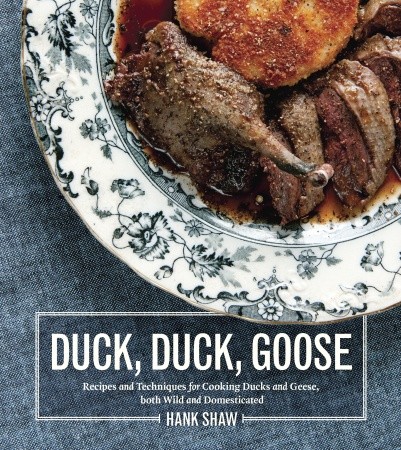




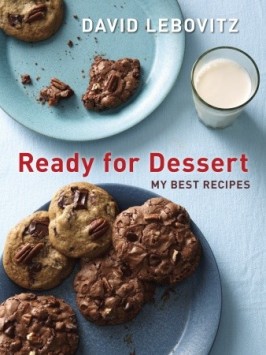
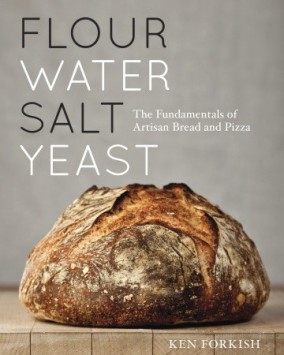
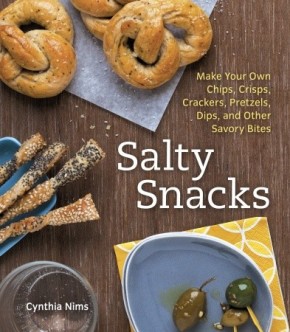
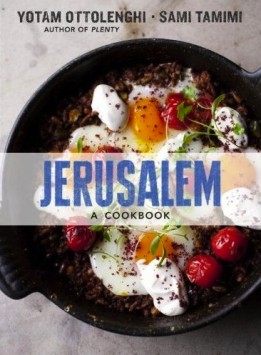
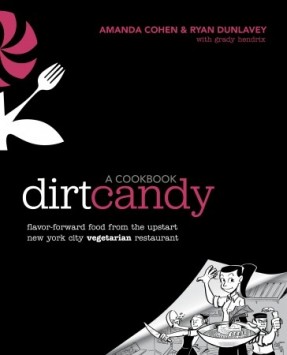
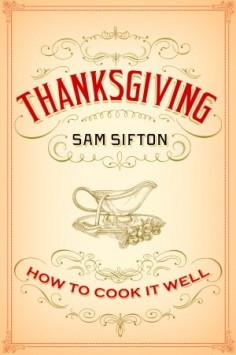
Leave a Reply